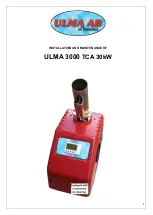
9
OPERATING INSTRUCTIONS
WARNING : Objects placed in front of the fire place
should be kept a minimum of 48” from the front face.
CAUTION : Never use gasoline, gasoline-type lantern
fuel, kerosene, charcoal lighter fluid, or similar liquids
to start or ‘freshen up ’a fire in this heater. Keep all
such liquids well away from the heater while it is in
use.
Your Napoleon EPA listed product is a Hi-Tech
unit,
designed with the most advanced technology. The unit is
extremely airtight. It has an exclusive direct outside air
supply (optional kit), a safety feature designed to prevent
spillage, and to keep your house free of carbon monoxide,
in case of a downdrafting chimney or an internal negative
pressure.
When lit for the first time
The stove will emit a slight odour for a few hours. This is a
normal temporary condition caused by the “burn-in” of
internal paints and lubricants used in the manufacturing
process and will not occur again. Simply open a window to
sufficiently ventilate the room during the first few hours of
operation.
To start, a brisk fire is required. Place loosely crumpled
paper on the grate and cover with dry kindling. Open the air
control fully by moving it to the right. Light the paper and
leave the door slightly ajar (one inch) until all kindling is
burning. To maintain a brisk fire, a hot coal bed must be
established and maintained.
Slowly add larger wood (2x4 size pieces). Lay the pieces
lengthwise from side to side in the hot coal bed with a
shallow trench between, so that the primary air can flow
directly into this trench and ignite the fuel above. When the
fire seems to be at its peak, medium sized logs may be
added. Once these logs have caught fire, carefully close
the door. (Closing the door too quickly after refuelling will
reduce the firebox temperature and result in an
unsatisfactory burn.) Remember it is more efficient to burn
medium sized wood, briskly, and refuel frequently than to
load the fireplace with large logs that result in a
smouldering, inefficient fire and dirty glass.
As soon as the door is closed, you will observe a change in
the flame pattern. The flames will get smaller and lazier
because less oxygen is getting into the combustion
chamber. The flames, however, are more efficient. The
flames will remain lazy but become larger again as soon as
the castings have been heated thoroughly and the
chimney becomes heated and provides a good draft.
At this point, the roaring fire that you see when the door is
opened is wastefully drawing heated room air up the
chimney — certainly not desirable. So always operate with
the door fully closed once the medium sized logs have
caught fire.
You can now add larger pieces of wood and operate the
stove normally. Once the stove is entirely hot, it will burn
very efficiently with little smoke from the chimney. There
will be a bed of orange coals in the firebox and secondary
flames flickering just below the top firebrick. You can safely
fill the firebox with wood to the top of the door and will get
best burns if you keep the stove pipe temperatures
between 250 degrees Fahrenheit (121 degrees Celsius)
and 450 degrees Fahrenheit (232 degrees Celsius). A
surface thermometer will help regulate this.
WITHOUT A STOVE THERMOMETER YOU ARE
WORKING BLINDLY AND HAVE NO IDEA OF HOW THE
STOVE IS OPERATING. A STOVE THERMOMETER
OFFERS A GUIDE TO PERFORMANCE.
Can’t get the stove going ?
Use more kindling and paper. Assuming the chimney and
vent are sized correctly and there is sufficient combustion
air, the lack of sufficiently dry quantities of small kindling is
the problem. Thumb size is a good gauge for small kindling
diameter.
Can’t get heat out of the stove ?
One of two things may have happened. The stove door
may have been closed prematurely and the stove itself has
not reached optimum temperature. Reopen the door
and/or draft control to re-establish a brisk fire. The other
problem may have been wet wood. The typical symptom is
sizzling wood and moisture being driven from the wood.
Achieving proper draft
Draft is the force which
moves air from the stove
up through the chimney.
The amount of draft in your
chimney depends on the
length and diameter of
chimney, local geography,
nearby obstructions and
other factors. Adjusting the
air control (Item B)
regulates the temperature.
The draft can be adjusted from a low burn rate with the
control fully closed, to a fast burn rate with the control fully
open.
Inadequate draft may cause back-puffing into the room
through the stove and chimney connector points and may
cause plugging of the chimney. Too much draft may cause
an excessive temperature in the stove, glowing red stove
parts or chimney connectors or an uncontrollable burn
which can lead to a chimney fire or permanent damage to
the unit.
B
+
_










































